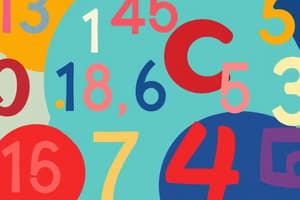Podcast
Questions and Answers
Which of the following numbers is considered rational?
Which of the following numbers is considered rational?
- -5/2 (correct)
- 3.14159
- π
- √2
Which characteristic is true for irrational numbers?
Which characteristic is true for irrational numbers?
- They have non-repeating, non-terminating decimals. (correct)
- They include integers.
- They have finite decimal representations.
- They can be represented as fractions.
What distinguishes rational numbers from irrational numbers?
What distinguishes rational numbers from irrational numbers?
- Rational numbers are always positive.
- Irrational numbers can be represented as fractions.
- Rational numbers can be expressed as a fraction while irrational numbers cannot. (correct)
- Rational numbers have an infinite number of decimal places.
Which decimal form can be associated with rational numbers?
Which decimal form can be associated with rational numbers?
Which of the following is an example of an irrational number?
Which of the following is an example of an irrational number?
Which statement is true regarding the relationship of rational and irrational numbers?
Which statement is true regarding the relationship of rational and irrational numbers?
Which of the following statements characterizes rational numbers?
Which of the following statements characterizes rational numbers?
Flashcards are hidden until you start studying
Study Notes
Rational Numbers
- Definition: Numbers that can be expressed as a fraction (a/b) where 'a' and 'b' are integers and 'b' is not zero.
- Characteristics:
- Can be either positive or negative.
- Includes integers, fractions, and finite or repeating decimals.
- Examples:
- Integers: -3, 0, 7
- Fractions: 1/2, -4/3
- Decimals: 0.75 (finite), 0.333... (repeating)
Irrational Numbers
- Definition: Numbers that cannot be expressed as a fraction of two integers.
- Characteristics:
- Have non-repeating, non-terminating decimal expansions.
- Cannot be exactly represented as a simple fraction.
- Examples:
- Common irrational numbers: √2, π (pi), e (Euler’s number)
- Notable property: The decimal expansion continues infinitely without repeating patterns.
Key Differences
- Representation:
- Rational numbers can be represented as fractions; irrational numbers cannot.
- Decimal Form:
- Rational: Terminating or repeating decimals; Irrational: Non-terminating, non-repeating decimals.
- Set Inclusion:
- All integers are rational; not all rational numbers are integers. Irrational numbers are separate and distinct from rational numbers.
Rational Numbers
- Numbers that can be written as a fraction
- Both numerator and denominator are integers
- Denominator cannot be zero
- Include integers, fractions, and decimals
- Can be positive or negative
Irrational Numbers
- Cannot be expressed as a fraction
- Have infinite and non-repeating decimal expansions
- Examples include: √2, π, e
Key Differences
- Rational numbers can be represented as fractions, while irrational numbers cannot
- Rational numbers have terminating or repeating decimals, irrational numbers have non-terminating and non-repeating decimals
- All integers are rational numbers
- All irrational numbers are not rational
Studying That Suits You
Use AI to generate personalized quizzes and flashcards to suit your learning preferences.




